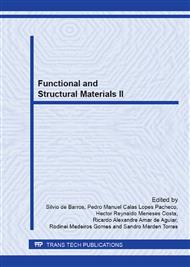p.83
p.89
p.99
p.107
p.113
p.119
p.125
p.133
p.139
Magnetic Annealing on GNO Electrical Steel Fe-3.25% Si
Abstract:
Grain non-oriented electrical steel has its main application in electrical motors and its microstructure significantly influences their efficiency. The objective of this work was to investigate whether or not magnetic field applied during annealing process affects grain growth and the development of important texture components leading to an improvement of the magnetic properties. GNO Fe-3.25%Si 75% cold rolled specimens were annealed inside magnetic field with strength of 17 T at the temperature of 800°C for 3, 10 and 30 minutes. Results of average grain size after magnetic annealing showed a microstructure formed by small grains and a few very large grains. Magnetic field did not increase orientation density of {100} oriented grains and Goss grains but was able to increase density of θ fiber and decrease the density of γ fiber.
Info:
Periodical:
Pages:
113-117
Citation:
Online since:
June 2013
Keywords:
Price:
Сopyright:
© 2013 Trans Tech Publications Ltd. All Rights Reserved
Share:
Citation:


